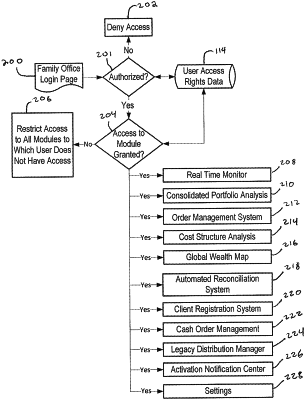| CPC G06Q 40/06 (2013.01) [G06Q 40/02 (2013.01)] | 21 Claims |

|
1. A system comprising:
a storage device; and
at least one processor coupled to the storage device, wherein the storage device stores (i) financial portfolio data representing financial and non-financial assets of an owner, (ii) node structure data representing a relationship of the assets in a hierarchical tree structure, and (iii) a program for controlling the at least one processor, and wherein the at least one processor, being operative with the program, is configured to:
add a new asset of the owner to the financial portfolio data by:
displaying within a graphical user interface on a computer a first pane comprising a plurality of objects each representative of a different asset type comprising at least a bank account asset type and a physical object asset type and a second pane comprising a hierarchical tree arrangement of the financial portfolio data based on the node structure data, wherein the hierarchical tree arrangement comprises a plurality of nodes including a root node and a plurality of descendant nodes of the root node, wherein the root node represents substantially the entire portfolio of the owner as identified in the financial portfolio data and the plurality of descendant nodes represent respective portions of the portfolio;
receiving a selection of a selected object from the plurality of objects in the first pane, wherein the selected object is movable between the first pane and the second pane;
dragging the selected object from the first pane to the second pane in response to receiving a selection input to drag the selected object from the first pane to the second pane;
dropping the selected object on an existing node from the plurality of nodes in the second pane in response to a dropping input of the selected object on the existing node in the second pane;
in response to dropping the selected object on the existing node, (1) adding the selected object to the node structure data such that the selected object is a node descendent from the existing node onto which the object node was dropped and (2) prompting input of information regarding the selected object as a function of an asset type and updating the financial portfolio data to reflect the new asset with the information, wherein to prompt for the bank account asset type comprises (i) prompting for a bank account number and authentication credentials to electronically access the bank account, wherein in response to receiving the input for information regarding the bank account asset type and (ii) updating the financial portfolio data to include the authentication credentials providing electronic access to the bank account associated with the selected object, wherein to prompt for the physical object asset type comprises (i) prompting for input of one or more photographs and (ii) updating the financial portfolio data with the photographs;
modify segmented user access rights of a plurality of users to update access permissions to different segments of the financial portfolio data based on respective user access rights of each respective user by:
displaying within a graphical user interface on a computer a visual representation of the financial portfolio data in a hierarchical tree arrangement based on the node structure data;
changing permission rights for a first user from solely allowing the first user to add new assets through the graphical user interface to allowing access to one or more nodes of the financial portfolio data through selection and/or deselection the one or more nodes in the hierarchical tree arrangement;
changing permission rights for a second user by receiving a selection and/or deselection of one or more nodes from the plurality of nodes in the hierarchical tree arrangement to configure which nodes corresponding with the financial portfolio data the second user is: (1) al lowed access; or (2) denied access, wherein the first user is different than the second user and user access rights for the first user allows access to a different portion of the financial portfolio data than user access rights for the second user;
enforce user access rights of the first user and the second user by:
determining which of the first user or the second user is a current user;
displaying within a graphical user interface on a computer a visual representation of the financial portfolio data in a hierarchical tree arrangement based on the node structure data;
monitoring for selection of a node of the plurality of nodes;
in response to selection of a node, automatically determine which of the descendant nodes of the selected object to hide based on the user access rights data associated with the current user; and
automatically expand the selected object to: (1) identify on the graphical user interface one or more descendant nodes of the selected object to which the current user has access based on the user access rights data, and (2) hide on the graphical user interface one or more of the descendant nodes of the selected object based on the user access rights data so that the visual representation of the financial portfolio data hides any nodes to which the current user does not have access; and
update the new asset of the owner by:
monitoring in real time for new transactions involving the new asset using the authentication credentials for the bank account and updating the new asset as a function of any new transactions.
|